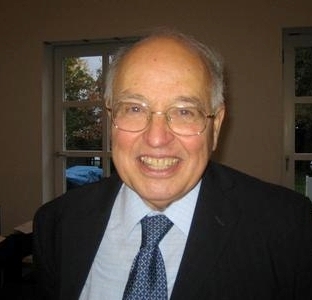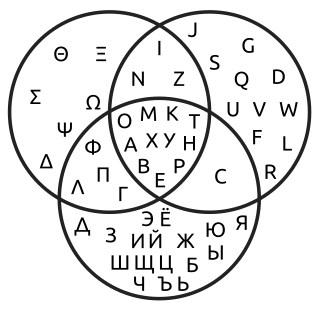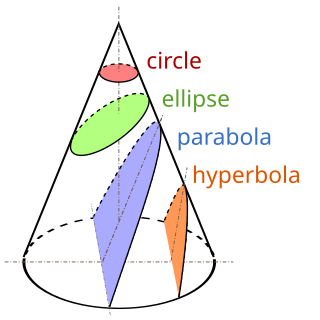
In geometry, the circumference is the perimeter of a circle or ellipse. The circumference is the arc length of the circle, as if it were opened up and straightened out to a line segment. More generally, the perimeter is the curve length around any closed figure. Circumference may also refer to the circle itself, that is, the locus corresponding to the edge of a disk. The circumference of a sphere is the circumference, or length, of any one of its great circles.

In mathematics, an ellipse is a plane curve surrounding two focal points, such that for all points on the curve, the sum of the two distances to the focal points is a constant. It generalizes a circle, which is the special type of ellipse in which the two focal points are the same. The elongation of an ellipse is measured by its eccentricity , a number ranging from to .

Sir Michael Francis Atiyah was a British-Lebanese mathematician specialising in geometry. His contributions include the Atiyah–Singer index theorem and co-founding topological K-theory. He was awarded the Fields Medal in 1966 and the Abel Prize in 2004.

A Venn diagram is a widely used diagram style that shows the logical relation between sets, popularized by John Venn (1834–1923) in the 1880s. The diagrams are used to teach elementary set theory, and to illustrate simple set relationships in probability, logic, statistics, linguistics and computer science. A Venn diagram uses simple closed curves drawn on a plane to represent sets. Very often, these curves are circles or ellipses.
In mathematics, a degenerate case is a limiting case of a class of objects which appears to be qualitatively different from the rest of the class; "degeneracy" is the condition of being a degenerate case.

An instanton is a notion appearing in theoretical and mathematical physics. An instanton is a classical solution to equations of motion with a finite, non-zero action, either in quantum mechanics or in quantum field theory. More precisely, it is a solution to the equations of motion of the classical field theory on a Euclidean spacetime.

In geometry, the midpoint is the middle point of a line segment. It is equidistant from both endpoints, and it is the centroid both of the segment and of the endpoints. It bisects the segment.

In mathematics, the eccentricity of a conic section is a non-negative real number that uniquely characterizes its shape.

In geometry, Poncelet's closure theorem, also known as Poncelet's porism, states that whenever a polygon is inscribed in one conic section and circumscribes another one, the polygon must be part of an infinite family of polygons that are all inscribed in and circumscribe the same two conics. It is named after French engineer and mathematician Jean-Victor Poncelet, who wrote about it in 1822; however, the triangular case was discovered significantly earlier, in 1746 by William Chapple.
Peter Benedict Kronheimer is a British mathematician, known for his work on gauge theory and its applications to 3- and 4-dimensional topology. He is William Caspar Graustein Professor of Mathematics at Harvard University and former chair of the mathematics department.

In geometry, an inscribed planar shape or solid is one that is enclosed by and "fits snugly" inside another geometric shape or solid. To say that "figure F is inscribed in figure G" means precisely the same thing as "figure G is circumscribed about figure F". A circle or ellipse inscribed in a convex polygon is tangent to every side or face of the outer figure. A polygon inscribed in a circle, ellipse, or polygon has each vertex on the outer figure; if the outer figure is a polygon or polyhedron, there must be a vertex of the inscribed polygon or polyhedron on each side of the outer figure. An inscribed figure is not necessarily unique in orientation; this can easily be seen, for example, when the given outer figure is a circle, in which case a rotation of an inscribed figure gives another inscribed figure that is congruent to the original one.

Robin Cope Hartshorne is an American mathematician who is known for his work in algebraic geometry.
In theoretical physics, the Penrose transform, introduced by Roger Penrose, is a complex analogue of the Radon transform that relates massless fields on spacetime, or more precisely the space of solutions to massless field equations, to sheaf cohomology groups on complex projective space. The projective space in question is the twistor space, a geometrical space naturally associated to the original spacetime, and the twistor transform is also geometrically natural in the sense of integral geometry. The Penrose transform is a major component of classical twistor theory.

A conic section, conic or a quadratic curve is a curve obtained from a cone's surface intersecting a plane. The three types of conic section are the hyperbola, the parabola, and the ellipse; the circle is a special case of the ellipse, though it was sometimes called as a fourth type. The ancient Greek mathematicians studied conic sections, culminating around 200 BC with Apollonius of Perga's systematic work on their properties.

In geometry, a line segment is a part of a straight line that is bounded by two distinct end points, and contains every point on the line that is between its endpoints. It is a special case of an arc, with zero curvature. The length of a line segment is given by the Euclidean distance between its endpoints. A closed line segment includes both endpoints, while an open line segment excludes both endpoints; a half-open line segment includes exactly one of the endpoints. In geometry, a line segment is often denoted using an overline (vinculum) above the symbols for the two endpoints, such as in AB.

A trammel of Archimedes is a mechanism that generates the shape of an ellipse. It consists of two shuttles which are confined ("trammeled") to perpendicular channels or rails and a rod which is attached to the shuttles by pivots at fixed positions along the rod.

In geometry, the director circle of an ellipse or hyperbola is a circle consisting of all points where two perpendicular tangent lines to the ellipse or hyperbola cross each other.
Nikita Alexandrovich Nekrasov is a Russian mathematical and theoretical physicist at the Simons Center for Geometry and Physics and C.N.Yang Institute for Theoretical Physics at Stony Brook University in New York, and a Professor of the Russian Academy of Sciences.
In mathematics, the Atiyah–Jones conjecture is a conjecture about the homology of the moduli spaces of instantons. The original form of the conjecture considered instantons over a 4-dimensional sphere. It was introduced by Michael Francis Atiyah and John D. S. Jones and proved by Charles P. Boyer, Jacques C. Hurtubise, and Benjamin M. Mann et al.. The more general version of the Atiyah–Jones conjecture is a question about the homology of the moduli spaces of instantons on any 4-dimensional real manifold, or on a complex surface. The Atiyah–Jones conjecture has been proved for ruled surfaces by R. J. Milgram and J. Hurtubise, and for rational surfaces by Elizabeth Gasparim. The conjecture remains unproved for other types of 4 manifolds.
In mathematics, the Gibbons–Hawking ansatz is a method of constructing gravitational instantons introduced by Gary Gibbons and Stephen Hawking. It gives examples of hyperkähler manifolds in dimension 4 that are invariant under a circle action.













